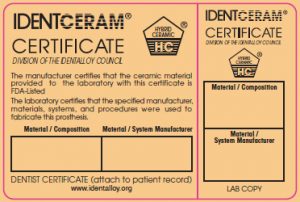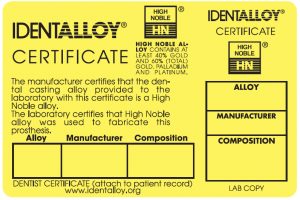By: Dee Kring, CAE, CMP, Executive Director
IdentAlloy Council, Inc.
The What’s In Your Mouth Campaign was created to raise awareness on dental related issues such as transparency and minimum standards. In most states, anyone can open a dental laboratory and call themselves a dental technician. However, there are voluntary certification programs such as the Certified Dental Technician program, the Certified Dental Laboratory program and the DAMAS Accredited Laboratory program.
But what about ensuring transparency and standards in materials contained in dental restorations? Shouldn’t dentists and patients have access to the patient contact materials contained in their dental restoration?

IdentAlloy Council is a 501(c)(6) nonprofit organization whose sole purpose is communicating raw material information regarding dental alloys and ceramics. The program provides valuable information from the material manufacturers to be used throughout the supply chain including dental laboratories, dentists, and ultimately to benefit the end user, the dental patient.
Manufacturers and suppliers of dental restorative materials must meet specific ADA material classifications. Dental manufacturers and suppliers participate voluntarily in the IdentAlloy/IdentCeram Certificate Program by becoming “licensees”.
After providing formal documentation of meeting ADA guidelines, licensees use certificates from IdentAlloy/IdentCeram which verify the material composition of their products. They provide these certificates, free of charge, to the dental laboratory and to the dentist.
I can share from my own personal experience the value of this program.
I recently had to go to my dentist who had advised I needed a crown. During the process, I went in for a temporary and then finally the permanent crown.
After my permanent crown was fitted and the dentist left the room, I asked the dental assistant “what’s in my mouth?” She replied “what do you mean? We fitted you with a crown”. “I know”, I said “but I’d like to know what my crown is made of”.

At this point, she opened my file and handed me an IdentAlloy certificate which named the manufacturer of the material, and the material composition found in the crown that was permanently affixed in my mouth.
The “recipe” didn’t necessarily mean that much to me, because I have no known allergies and therefore wasn’t looking for a particular material, but there was a certain reassurance I felt by knowing exactly what was in my mouth. Having the certificate also made me feel an even greater level of trust in my dentist, and that he values quality in the products he uses, as well as values transparency with his patients. After all, I (along with my insurance provider) paid good money for this crown and it is, after all, in my body. I have a right to know.
So, it is important that patients ask their dentist, dentists ask their dental laboratories, and dental laboratories ask their manufacturers about the materials used in their dental restorations.
If you’d like to find out more about the IdentAlloy/IdentCeram program, who participates or how you can too, please visit http://identalloy.org/ or contact me at 888-577-2634, or dkring@identalloy.org.

Cover photo courtesy of Image © Matt Madd/Dentist; https://costculator.com/dentist/

Dee Kring, CAE, CMP, serves as Executive Director of IdentAlloy Council, Inc. She has over twenty years of experience working with nonprofit associations including national and state trade associations and professional societies. Dee resides in Tallahassee, Florida, where she is past President of the Tallahassee Society of Association Executives and a current board member of the Florida Society of Association Executives.








Excellent site you have got here, it is really well made. Thank you for writing this informative blog, looking forward for more!